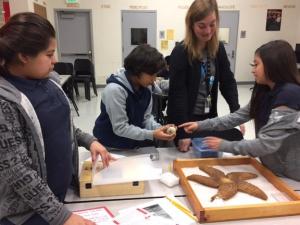Design Thinking in Middle School: A Human-Centered Approach to 21st Century Learning Vision

Technology advances at a rapid pace. So fast that it often outpaces advancements in education policy and practice. Students are often way ahead of the curve while teachers who learned pedagogical methods in days when there were many less avenues for incorporating technology into classrooms lag far behind them in terms of technological facility. This is compounded by the fact that every student learns in a different way, and with more and more options, it gets increasingly difficult to cater to the individual needs of students. This is what makes the Design Thinking in Middle School: A Human-Centered Approach to 21st Century Learning Vision project really stand out. They aim to bolster the technological aptitude of their educators while designing more individualized curriculum for their students. In pursuit of this vision for student learning, a team of teachers at Southeast Middle School applied with their Board of Education to open a magnet center on campus. The focus of this magnet center is to bring a three “I” – Interest, Impact, and Innovation- driven approach to teaching and learning.
Goals
In order to better understand where they find themselves as of their last progress report, it’s important to understand the goals they set out to accomplish.
Students will work on collaborative, cross-curricular projects that center on design thinking, a powerful learning tool that teaches students to use empathy and critical thinking to tackle problems of any kind from a human-centered point of view. In their model, the teacher’s role is to provide opportunities for discovery and to guide students to understanding through their innovation projects. The transition from a teacher-centered, depository learning framework to a student-centered, design-based learning approach requires teachers to work in a highly collaborative environment to develop cross-curricular and student-centered projects.
So, in their first year, how did they go about doing this?
Before they could start they had to answer a few key questions for themselves, and anyone looking to replicate this program would do well to do the same.
- What resources are currently available and/or necessary to obtain in order to successfully realize their stated vision?
- How might the concepts learned in the theme-based professional development activities be applied to their specific school context?
- What effect(s) might a design thinking approach to teaching and learning have on school performance, as measured by five instructional pillars (teaching) and the ISTE 21st century skill standards (learning)?
These questions guided their approach and the following methods were applied.
- Conduct a needs assessment and establish a teacher growth plan,
- Plan and implement teacher developed lessons tailored to the classroom context, and
- Evaluate the impact of the project on student learning and extract teacher learning through reflective practices.

Their first year found its focus in the first two milestones. One of their priorities this year was to help the new magnet teachers build a theoretical grounding in the foundations of design thinking in K-12 education. They found early on in the project that this looked different for every teacher, based on their subject area, experience level, and their personal interests in areas of growth. Because of these disparate levels of experience, as a team, they decided that more experienced teachers would take on a more robust menu of learning opportunities that were designed to fill in gaps in theoretical and clinical knowledge and to prepare themselves to be teacher leaders in the new school. Their primary learning focus as a teacher leader team was to increase their capacity to understand and teach in alignment with a program theme of design thinking through project-based learning.
So, a year in, where are they?
Their collection of professional development opportunities during Year One has helped teachers develop a greater capacity for executing the magnet program’s vision of developing a human-centered approach to 21st century learning. Teacher leaders are using their learnings from model school visits, workshop and trainings, and collaborative planning sessions, to develop a comprehensive instructional technology plan, to plan and implement theme-based lessons tailored to their classroom contexts, and to develop a comprehensive introductory professional development plan for novice teachers. This included the teacher leaders themselves sharing their learnings through professional development sessions that they curated from their experiences in Year One of the project.
Students were able to develop their skills as digital citizens, innovative designers, knowledge constructors, creative communicators, empowered learners, and global collaborators through design-based, project-based learning tasks throughout the school year. Additionally, they were able to showcase their learning at multiple community events at their school site and within the larger learning community of South Gate. News and pictures of the events were shared on the school website at <http://southeastms-lausdca.schoolloop.com/>. Teacher-leaders are currently designing their digital portfolios to showcase their student projects on the magnet program website <www.dreamsmagnet.org>.
But no project is without challenges. What were some that they faced?
The biggest thing they had to contend with was finding substitute teachers within the budget. This allowed the participating educators to take time off from class for professional development. This is being solved in the second year by reallocating some of the grant money to pay for that.
It’s never too late to educate yourself on the latest technology. Even though chances are, by the time you’ve mastered it there will be something new. But that shouldn’t stop us from trying to narrow the technology gap between students and educators, and this project sounds like one way to do it.

